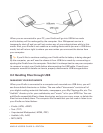
KINDLE USER’S GUIDE 3
rd
EDITION · 104 ·
Tip: Mobipocket files must have no Digital Rights Management (DRM) protection
applied to be readable on your Kindle. If you purchased a Mobipocket file from a
Mobipocket retailer, you will not be able to open the file on your Kindle.
TRANSFERRING YOUR CLIPPINGS
Your clippings are stored in a file called “My Clippings.txt,” which is located in the
“documents” directory. If you want to copy the clippings from your Kindle to your
computer so you can edit them, e-mail a passage to a friend, or just archive your
clippings, you can drag and drop the “My Clippings.txt” file onto your computer.
Clippings and other annotations are described in more detail in Chapter 3.
8.3 Converting and Transferring Your Documents
In addition to reading commercially available materials, you can have Amazon convert
your personal documents into a Kindle-compatible format for reading on your Kindle.
You can have the converted files sent wirelessly to your Kindle for a small fee or to the
e-mail address associated with your Amazon account for free.
SUPPORTED FORMATS FOR CONVERSION
In addition to the file formats listed above, you can also convert other personal
documents to read on your Kindle. The supported file formats are listed below:
• Microsoft Word (.DOC)
• RTF
• PDF
• Structured HTML (.HTML, .HTM)
• JPEG (.JPEG, .JPG)
• GIF (.GIF)
• PNG (.PNG)
• BMP (.BMP)
• Compressed ZIP (.ZIP)
Note: PDF conversion is currently an experimental feature on Kindle. Due to PDF’s
fixed layout format, some complex PDF files might not format correctly on your Kindle.
Tip: ZIP files are automatically opened up by the conversion service if you choose
to compress your documents. Any enclosed files listed above inside the ZIP file will be
converted and sent to your Kindle or computer as specified.


















